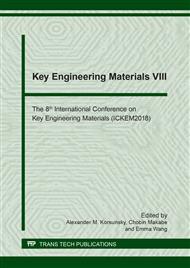[1]
W.B. Huang, D. Li, J. Huang, R. Zhang and Y.Z. Feng, Study on the Vibration Performance of a Multi-layer Flat Restrained Damping Structure, International Conference on Transportation Infrastructure and Materials, (2017).
DOI: 10.12783/dtmse/ictim2017/10065
Google Scholar
[2]
B. Khalfi and A. Ross, Influence of partial constrained layer damping on the bending wave propagation in an impacted viscoelastic sandwich, International Journal of Solids and Structures, 25-26 (2013) 4133-4144.
DOI: 10.1016/j.ijsolstr.2013.07.023
Google Scholar
[3]
Y.C. Feng, H. Zhan and S.M. Tang, Design for Vibration Control with Constrained Partial Damping Based on Modal Analysis, Ship Science and Technology,11 (2011) 22-26.
Google Scholar
[4]
A.K. Lall, N.T. Aanani and B.C. Nakra, Vibration and Damping Analysis of Rectangular Plate With Partially Covered Constrained Viscoelastic Layer, Journal of Vibration and Acoustics, 3 (1987) 241-247.
DOI: 10.1115/1.3269427
Google Scholar
[5]
W. Zheng, Y. Lei, S. Li and Q. Huang, Topology Optimization of Passive Constrained Layer Damping with Partial Coverage on Plate, Shock and Vibration, 2 (2013) 199-211.
DOI: 10.1155/2013/360327
Google Scholar
[6]
P. Lyu, J.G. Gao, J. Li and Z.W. Bo, Impacting Factors of Damping Performance of Constraint Damping Structures, Noise and Vibration Control, 05 (2014) 234-238.
Google Scholar
[7]
W.B. Huang, D. Li, L.Q. Liang, Y.L. Li and H.G. Sun, The Study on the Modal Experimental of the Strip Interface Constrained Damping Structure, World Transport Convention, (2017).
Google Scholar
[8]
H.R. Shi, P. Gao, Z.G. Li, D.Y. Zhao and J.P. Zhao, Vibration Analysis and Optimization Design of a Cylindrical Shell Treated with Constrained Layer Damping, Journal of Vibration and Shock, 22 (2013) 146-151.
Google Scholar
[9]
D. Li and Q.H. Lu,Optimal Design for Partial Constrained Layer Damping, Journal of Tsinghua University (Science and Technology), 12 (2011) 1877-1881.
Google Scholar
[10]
W.B. Huang, J.G. Gao and J. Li, Research of Damping Property of Viscoelastic Damping Materials 501 and Structure, Development and Application of Materials, 04 (2014) 82-85.
Google Scholar


